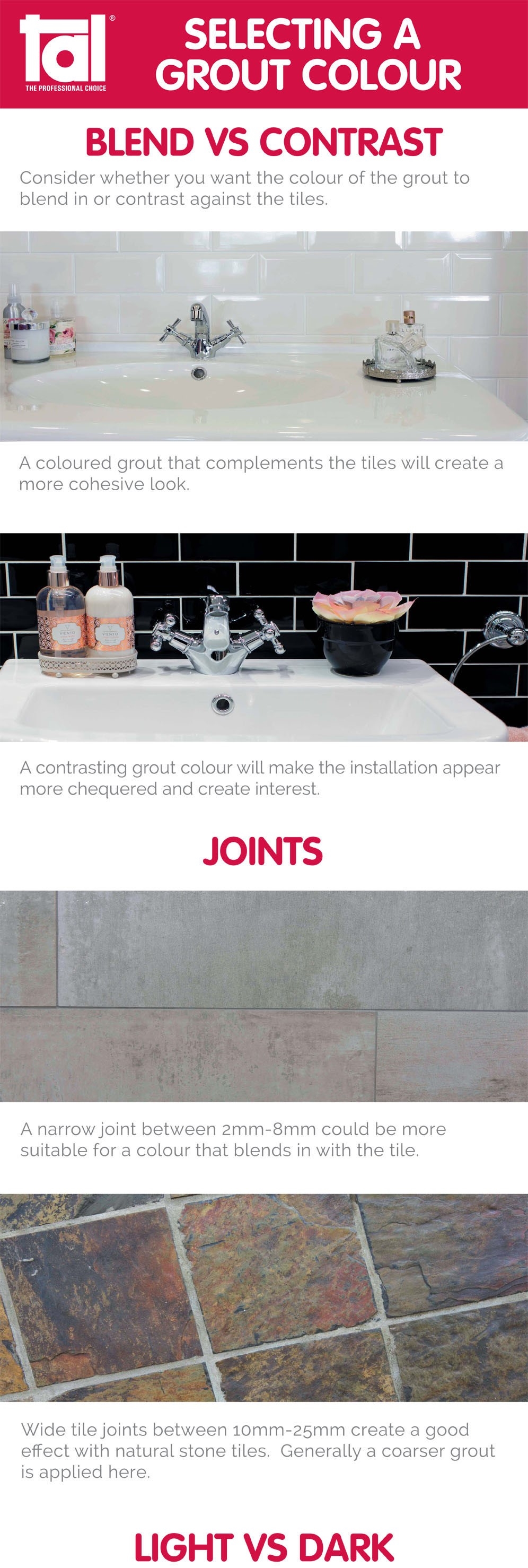Tips on selecting the perfect grout colour
Update 2018-10-08
Click here to download TAL’s Guide to Selecting the Perfect Grout Colour
When tiling, many people spend days over the choice of tiles: What kind of tile, what shape and what colour? Selecting the grout, which fills the space between the tiles, is often a mere afterthought. TAL believes that grout deserves more attention and respect as it adds to the overall look of the installation. As a result, we have developed a guide of some of the key considerations when selecting a grout colour.


Blend vs. Contrast
Consider whether you want the colour of the grout to blend in or contrast against the tiles. A coloured grout that complements the tiles will create a more cohesive look; while a contrasting grout colour will make the installation appear more chequered and create interest.
Narrow Joints vs. wide Joints
Another area which is often overlooked is the width of the tile joint space in an installation. You can have a narrow tile joint of between 2mm and 8mm which could be more suitable for a colour that blends in with the tile colour. Alternatively, a wide grout joint of between 10mm and 25mm – usually seen in natural stone tile installations – creates an interesting visual effect. However generally speaking wider grout joints require a coarser grout.
Light vs. Dark Grout
Grout in high-traffic areas, such as entrance halls, walkways and commercial installations, is more likely to discolour. In this circumstance, we would recommend using TAL’s Wall and Floor grout in dark grey or dove grey for best results in the long term. Light coloured grout is more suitable for wall tiles and low traffic areas which tend to stay clean for longer.
Colours
TAL provides grout colour sample boards in-store and colour cards you can take home – both of which make it easier for you to select the ideal grout colour. If in doubt, remember that the colour of the grout in powder form is the same colour as grout that has been cured in the tile joint once it has been mixed with water. This is why TAL Wall and Floor grout bags have a clear window so that you can see the actual colour of the grout.
Additives and Sealers
Once you have selected the type and colour of the grout, you now need to think about additives and sealers. A latex additive such as TAL Bond is recommended as a total water replacement in the grout mix to improve the water resistance, flexibility and bond strength of the grout. Bear in mind that when an additive such as TAL Bond is used instead of water in the grout mix, the colour of the grout will deepen. Alternatively, TAL Bond Powder may be added to the adhesive mixing water, at a ratio of 1 x 1kg satchet per 20kg tile adhesive.
For more grout related tips and tricks, use the following resources:
- TAL Grout Calculator: Allows you to work out exactly how much grout is needed for a tiling installation
- TAL Grout Selection Guide: Matches products from within the TAL grout range to whichever tile is being used, as well as the area (wet, high-traffic etc)
- TAL Grout Catalogue: Each of TAL’s grouting products are summarised in this catalogue, along with Material Data Safety Sheets (MSDS) and Technical Data Sheets on each product
If this TAL Talk post interested you, you may want to take a look at another TAL Talk blog post: What to do about soft crumbling grout?
[Back]
blog comments powered by Disqus

